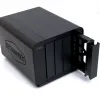Configuring/adding new users/groups
The software installation process begins with the setup of a default account titled 'admin,' which acts as the initial user profile. It is strongly advised to modify the default username and password to enhance security. Upon verifying your email address, you will notice that this admin account is set up to permit Secure Shell (SSH) access, allowing remote command-line interface interactions. As an administrator, accessing the Terminal Operating System (TOS) through SSH provides you with unrestricted control, enabling you to manage and execute a wide range of tasks within the system. Make sure you choose a strong password though and preferably block ports from your WAN side.
Within the network drive, the software offers the functionality to create additional user accounts, organize them into groups, and establish new directories, all through a user-friendly web interface. This system draws inspiration from Linux-based user group management, allowing for collaborative file management among users. Users can not only manage their own files but also interact with files created by others within their group, including editing and, where applicable, executing these files, all facilitated by an intuitive graphical user interface (GUI).
By default, the system is equipped with two primary directories: "Public" and "AppData." These directories are designed for shared access and application-specific data storage, respectively. Users can effortlessly augment the system with new files or directories via the file management interface, and the option to encrypt files adds an extra layer of security.
To ensure integration with your PC and facilitate file sharing and access, it is essential to activate the Samba service. Samba, which is disabled by default for security reasons, allows your networked devices to communicate with the TOS, making file access across different operating systems seamless. Enabling Samba transforms the TOS into a versatile file server, bridging the gap between various operating systems and enhancing the overall utility of the network drive.




